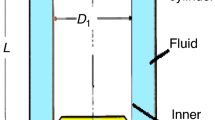Abstract
We developed a simple viscosity measurement method to directly evaluate the period and logarithmic decrement of oscillation. The viscosity of a molten metal is an important thermophysical property for production at high temperatures. However, the viscosities of molten metals are relatively low and difficult to measure because of challenges involved in their handling. Among several methods available for measuring viscosity, the oscillating crucible method is generally used with molten metals. The conventional method involves an approximation using a multistep iteration to determine the viscosity. The first step assumes that the oscillation period does not change and that only the amplitude decays. This method also assumes that the center of oscillation is close to the center of the array of photodiodes. Thus, it is necessary to consider whether the conditions are within a valid approximation range. In addition, it is necessary to determine the on/off thresholds to obtain binary data from the photodiode outputs. In this study, we developed a simple viscosity measurement method based on the principle of least squares to derive the period and logarithmic decrement of oscillation. To confirm the reproducibility of the proposed method, the viscosity of molten nickel was measured and found to be in good agreement with those reported in the literature. The measurement error was less than ± 3 %. Further, the experimental data showed good reproducibility, and the measurements were obtained with high accuracies using the proposed method.










Similar content being viewed by others
Data Availability
Please contact the corresponding author.
Code Availability
In principle, not available. If needed, please contact the corresponding author.
References
Y. Sato, K. Sugisawa, D. Aoki, T. Yamamura, Meas. Sci. Technol. 16, 363 (2005). https://doi.org/10.1088/0957-0233/16/2/006
D.K. Belaschoeneko, Dokl. Akad. Nauk. SSSR 117, 98 (1957)
Y. Kawai, Proc. ICSTIS Suppl. Trans. ISIJ 11, 387 (1971)
Revised 4th Edition Metal Data Book, ed. by The Japan Institute of Metals and Materials, Maruzen, Tokyo (2004), p. 69 [in Japanese].
E.N. Da, C. Andrade, E.R. Dobbs, Proc. R. Soc. 12, A211 (1952)
G. Cavalier, NPL Symp. Phys. Chem. Metal. Sol. Intermetal. Compd. 4D (1959).
T. Ejima, Y. Sato, S. Yaegashi, E. Takeuchi, K. Tamai, J. Jpn. Inst. Met. 51, 328 (1987)
T. Ejima, Y. Sato, T. Yamamura, A. Hayashi, T. Yamazaki, J. Jpn. Inst. Met. 54, 1005 (1990). https://doi.org/10.2320/jinstmet1952.54.9_1005
W. Rhim, S.K. Chung, D. Barber, K.F. Man, G. Gutt, A. Rulison, R.E. Spjut, Rev. Sci. Instrum. 64, 2961 (1993). https://doi.org/10.1063/1.1144475
T. Ishikawa, P.F. Paradis, J. Okada, M.V. Kumar, Y. Watanabe, J. Chem. Thermodyn. 65, 1 (2013)
I. Egry, G. Lohöfer, I. Seyhan, S. Schneider, B. Feuerbacher, Appl. Phys. Lett. 73, 462 (1998). https://doi.org/10.1063/1.121900
K. Higuchi, H.-J. Fecht, R.K. Wunderlich, Adv. Eng. Mater. 9, 349 (2007). https://doi.org/10.1002/adem.200600277
G.I. Tayler, Philos. Trans. R. Soc. Lond. A. 223, 289 (1923)
J.O. Bockris, D.C.J. Lowe, J. Sci. Instrum. 30, 403 (1953). https://doi.org/10.1088/0950-7671/30/11/306
R.F. Brooks, A.T. Dinsdale, P.N. Quested, Meas. Sci. Technol. 16, 354 (2005). https://doi.org/10.1088/0957-0233/16/2/005
R. Roscoe, Proc. Phys. Soc. 72, 576 (1958). https://doi.org/10.1088/0370-1328/72/4/312
T. Ejima, T. Yoko, G. Saito, Y. Kato, J. Jpn. Inst. Met. 43, 929 (1979). https://doi.org/10.2320/jinstmet1952.43.10_929
T. Ohta, O. Borgen, W. Brockner, D. Fremstad, K. Grjotheim, K. Tørklep, H.A. Øye, Ber. Bunsen Ges. Phys. Chem. 79, 335 (1975). https://doi.org/10.1002/bbpc.19750790405
D.C. Sorensen, SIAM J. Num. Anal. 19, 409 (1982). https://doi.org/10.1137/0719026
FindMinimum, Wolfram Language and System Documentation, https://reference.wolfram.com/language/ref/FindMinimum.html
Unconstrained Optimization: Step Control, Wolfram Language and System Documentation, https://reference.wolfram.com/language/tutorial/UnconstrainedOptimizationStepControl.html
R.F. Brooks, I. Egry, S. Seetharaman, D. Grant, High Temp. High Press. 33, 631 (2001). https://doi.org/10.1068/htwu323
H. Kokubo, T. Nishi, H. Ohta, H. Yamano, J. Japan Inst. Met. Mater. 82, 400 (2018). https://doi.org/10.2320/jinstmet.JAW201812
T. Nishi, R. Sato, H. Ohta, H. Kokubo, H. Yamano, J. Nucl. Mater. 552, 153002 (2021). https://doi.org/10.1016/j.jnucmat.2021.153002
Acknowledgments
This work was supported by the “Technical development program on a fast reactor international cooperation, etc.” entrusted to the Japan Atomic Energy Agency (JAEA) by the Ministry of Economy, Trade, and Industry (METI). We appreciate the support of Y. Takatsuka and S. Matsumoto of Ibaraki University as well as H. Sato and T. Uno of PASONA Inc and H. Kokubo of Nabtesco Corporation.
Funding
This work was supported by the “Technical development program on a fast reactor international cooperation, etc.” entrusted to the Japan Atomic Energy Agency (JAEA) by the Ministry of Economy, Trade and Industry (METI).
Author information
Authors and Affiliations
Contributions
TN: Conceptualization, methodology, validation, investigation, data curation, writing original draft, writing review, and editing. RS: Data curation, writing original draft, writing review, and editing. HO: Methodology, formal analysis, investigation. HY: Investigation, writing review, editing, and funding acquisition.
Corresponding author
Ethics declarations
Conflict of interest
The authors declare that they have no known competing financial interests or personal relationships that could have influenced the work reported in this paper.
Additional information
Publisher's Note
Springer Nature remains neutral with regard to jurisdictional claims in published maps and institutional affiliations.
Rights and permissions
About this article
Cite this article
Sato, R., Nishi, T., Ohta, H. et al. Viscosity Measurements of Molten Metal Using an Improved Oscillating Crucible Method. Int J Thermophys 43, 85 (2022). https://doi.org/10.1007/s10765-022-03011-2
Received:
Accepted:
Published:
DOI: https://doi.org/10.1007/s10765-022-03011-2




